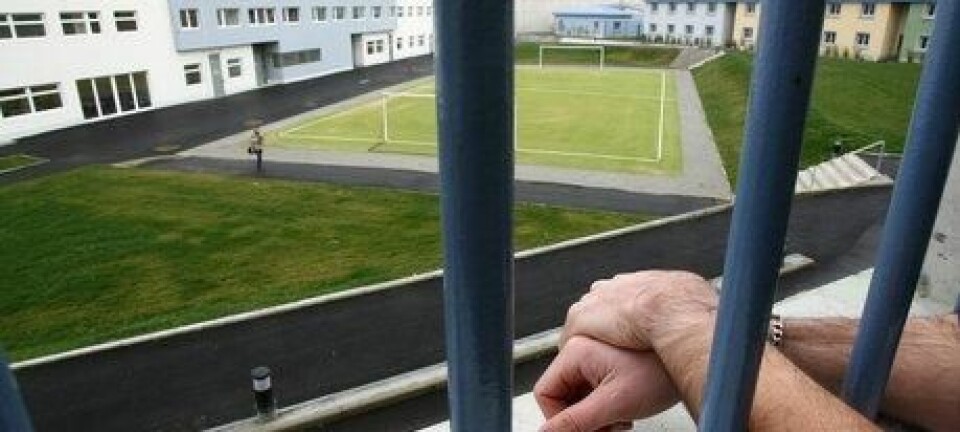
Prisoners unhappy with drug addiction treatment in jail
Prisoners share narcotics with fellow inmates as an act of solidarity but this also creates tensions. Convicts react to what they see as unfair differences in treatment.
Denne artikkelen er over ti år gammel og kan inneholde utdatert informasjon.
A large proportion of inmates in Norwegian prisons have substance abuse problems and troubles with living conditions and a straight life outside in society. As a result, prison and probation authorities have intensified rehab measures.
Kristian Mjåland at the Uni Research Rokkan Centre and the University of Bergen has studied treatment for substance abuse is practiced in a Norwegian prison and how rehab affects daily life there.
Employees as well as inmates describe major shortcomings in the rehab system.
A third do drugs behind bars
Most of the inmates take drugs less inside jail than outside. Earlier research has shown, however, that about a third of all convicts use drugs while they are doing time. And quite a few actually make their debuts with narcotics inside prison.
The most frequently used drugs inside European prisons are cannabis, cocaine and heroin. But the story is differs a little in Norway.
Subutex sought after
A national survey in 2002 showed that cannabis, amphetamines and heroin were the substances used most often by inmates in Norwegian prisons. But in the last ten years there has been a troublesome increase in use of subutex and subuxone.
In the jail studied by Mjåland both staff and prisoners said that the commonest drugs used were subutex and subuxone.
These are prescription medications produced for use in treatment of addiction to opiates such as heroin. But there is also an illegal street market for them.
Outside factors and self-volition
International research shows that substance abuse in prisons has little to do with the individual choices among those who are incarcerated:
“The question of whether they use or abstain from using narcotics while serving time is largely dependent on the availability of drugs, the properties of the drugs – whether they tranquilise, relax or sedate – and how tightly controls are enforced, rather than the inmates’ individual willpower or motivation,” says Mjåland.
Culture of sharing
International research has also shown that many prisoners build up a drug debt behind bars. The price of drugs is often three or four times higher than out on the street and it is easy to incur a debt, at least in other countries.
“I found surprisingly little buying and selling of drugs in the jail I studied,” says Mjåland.
Instead, he found an extensive culture and economy based on trading and sharing.
“Those who now get hold of drugs shared them with others who wanted them. The culture for sharing was based on expected mutuality. They expected receivers to share with them the opportunity arose in the future,” says Mjåland.
These are mandatory norms involving strong social controls, making it hard to keep away from it all.
“The inmates say this activity creates solidarity, tensions and social cohesion,” he explains.
Smashed expectations
But drug rehabilitation programmes don’t live up to the expectations of inmates and prison staff. The convicts report unfulfilled expectations regarding rehab efforts in jail. In the prison which
Mjåland studied, the guards and other staff also admitted that rehab schemes were not working like they should.
Prisoners spoke of empty content and unfair, differential treatment.
“This contributes to randomness and insecurity,” says Mjåland.
It is hard to figure who will be included who won’t, according to those who are doing time.
Disparate treatment
They feel that prisoners are arbitrarily rewarded or punished, for instance with regard to grants of leaves or sanctions for drug use. This perceived random practice undermines the legitimacy of rehab programmes.
The convicts also think the selection of prisoners for placement in such programmes is also unpredictable.
A jail can have a lot of inmate turnover because as many are only being held in custody or are scheduled for transfers to other jails. Norway’s queue of persons convicted of crimes who waiting to serve their jail sentences also adds pressure.
Mjåland adds that prisoners’ quandaries about whether or not their pleas for release will be granted after serving two-thirds of their sentences leads to suspense among the inmates and social workers who are supposed to help them they get out the gates.
He says that all these issues put the squeeze on the principle of just and equal treatment.
Guards in mix of roles
The guards and staff get important roles in rehabilitation efforts. This makes for a difficult mix of roles as guards, service providers, controllers and therapists.
In the jail Mjåland studied, the unit trying to get prisoners to beat their addictions not shut off from regular wards, a practice that research shows to be important for successful results.
Employees dissatisfied too
The staff also said that drug rehab efforts inside prison failed to live up to their expectations.
To sum up their criticism, programmes were less meaningful than expected. They complained of insufficient work with the penal environment and more pervasive use of drugs despite their efforts.
Employees said the causes for this included a lack of capacity and that a focus on security and logistics had to be given priority over rehabilitation, teaching inmates to tackle substance abuse and helping them to alter their behaviour.
Mjåland stresses that his findings cannot necessarily be extrapolated to cover all Norwegian jails.
“Nevertheless, we have grounds for saying that drug rehab schemes in many prisons can and should be run better,” says Mjåland.
-----------
Read the Norwegian version of this article at forskning.no
Translated by: Glenn Ostling
Scientific links
- Kristian Mjåland: A culture of sharing: Drug exchange in a Norwegian prison. doi: 10.1177/1462474514527149 Punishment & Society July 2014 vol. 16 no. 3 336-352
- Kristian Mjåland og Ingrid Rindal Lundeberg: Penal hybridization: staff- prisoner relationships in a Norwegian drug rehabilitation unit. Juridification and Social Citizenship in the Welfare State. Cheltenham: Edward Elgar Publishing, DOI:10.4337/9781783
































